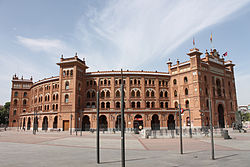Las Ventas
| Las Ventas | |
|---|---|

Las Ventas bullring
|
|
| Former names | Las Ventas del Espíritu Santo |
| General information | |
| Type | Bullring |
| Architectural style | Neo-Mudéjar |
| Address | c/ Alcalá, 237 28028 Madrid |
| Town or city | Madrid |
| Country | Spain |
| Coordinates | 40°25′55.5″N 3°39′47.8″W / 40.432083°N 3.663278°W |
| Current tenants | Taurodelta |
| Inaugurated | June 17, 1931 |
| Owner | Comunidad de Madrid |
| Design and construction | |
| Architect | José Espeliu |
| Other information | |
| Seating capacity | 23,798 |
| Website | |
| www.las-ventas.com | |
| Plaza de Toros de Las Ventas | |
|---|---|
|
Native name Spanish: Las Ventas |
|
 |
|
| Location | Madrid, Spain |
| Coordinates | 40°25′56″N 3°39′48″W / 40.432107°N 3.663343°WCoordinates: 40°25′56″N 3°39′48″W / 40.432107°N 3.663343°W |
| Official name: Plaza de Toros de Las Ventas | |
| Type | Non-movable |
| Criteria | Monument |
| Designated | 1994 |
| Reference no. | RI-51-0008990 |
Plaza de Toros de Las Ventas (often shortened to Las Ventas) is a famous bullring located in Madrid, Spain.
Situated in the Guindalera quarter of the district of Salamanca, it was inaugurated on June 17, 1931. It has a seating capacity of 25,000.
This bullring was designed by the architect José Espeliú in the Neo-Mudéjar (Moorish) style with ceramic incrustations. The seats are situated in ten "tendidos". The price of the seats depends upon how close they are to the arena and whether they are in the sun or the shade (the latter being more expensive). The bullfighting season starts in March and ends in October; bullfights are held every day during the San Isidro Fiesta, and every Sunday or holiday during the season. Bullfights start at 6 or 7pm and last for two to three hours.
"Las Ventas" is located in the east of Madrid.
From 1913 to 1920, the national passion (bullfighting) gained such an important status that Madrid's former main bullring in Carretera de Aragón was not big enough. It was José Gómez Ortega "Joselito" who declared that a new "monumental" bullring had to be built, to open this part of Spain's heritage and culture to the whole city of Madrid. His friend the architect José Espeliú began to work on the project.
A family called Jardón donated the land to the Madrid Provincial Council, provided that they could run the arena for fifty years. The deputation accepted the proposal on November 12, 1920. On March 19, 1922, in the exact center of the prospective arena, the first stone was placed. The construction of the bullring would cost 12 million pesetas (4.5 million over budget), and it would replace the old bullring, dating from 1874.
"Las Ventas" was finished in 1929 and two years later, June 17, 1931, a charity bullfight was held with a full-capacity crowd to inaugurate it. Bullfighting stopped during the Spanish Civil War and did not resume until May 1939.
There is a Pasodoble called 'Plaza de las Ventas' and the composer Maestro Manuel Lillo dedicated to this arena.
"Las Ventas" is divided into a ring or arena, and a group of zones called "patios". Its architecture is Neo-Mudéjar, with ceramic representations of the heraldic crests of the different Spanish provinces. The arena has a diameter of 60 meters. The seating capacity is divided into 10 "tendidos" (group of 27 rows around the arena), some of them in the shade and the rest in the sun.
...
Wikipedia

